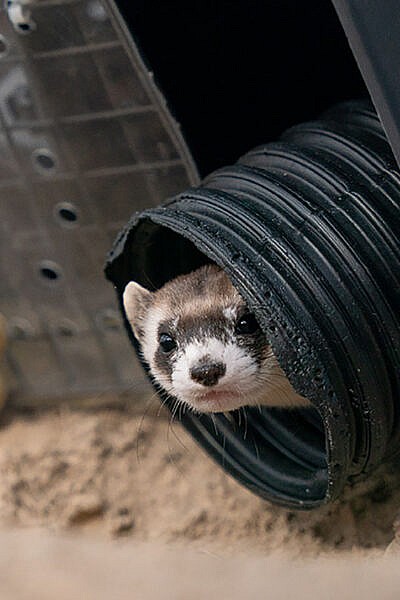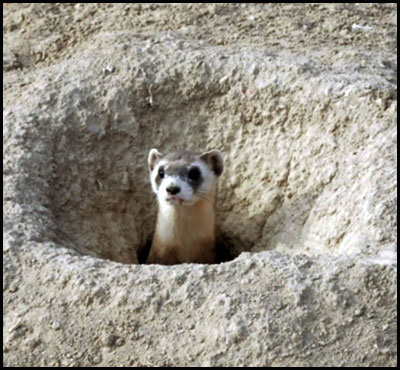 It was a big year to celebrate for black-footed ferret (BFF) conservation enthusiasts. Including Cheyenne Mountain Zoo’s kits, 417 BFF kits were born into the program. That’s the most kits born in a single year program-wide in a decade!
It was a big year to celebrate for black-footed ferret (BFF) conservation enthusiasts. Including Cheyenne Mountain Zoo’s kits, 417 BFF kits were born into the program. That’s the most kits born in a single year program-wide in a decade!
Led by the Association of Zoos and Aquariums Black-Footed Ferret SAFE (Saving Animals From Extinction) and U.S. Fish & Wildlife Service, breed-and-release programs at Cheyenne Mountain Zoo, Smithsonian National Zoo and Conservation Biology Institute, Phoenix Zoo, Toronto Zoo, Louisville Zoo and National Black-Footed Ferret Conservation Center work together to save the species. CMZoo contributed 21 kits this year and released 12 kits and 2 beyond-breeding-age adults into wild conservation habitats in Colorado.
Once the kits are old enough to live independently – around 3 months old – they are transported from the conservation center at CMZoo to BFF ‘boot camp,’ in Fort Collins, where they spend time in a pre-release pen that simulates the opportunities and challenges they’ll encounter in the wild. When they prove they can hunt, find shelter and survive in the pre-release pen, they are cleared for wild release. Ferrets that don’t graduate from boot camp are brought back to support breeding efforts or serve as ambassadors for their species, if they’re too old to reproduce.
In November, CMZoo staff and board members traveled to protected prairie lands in Pueblo, Colo., to see the ferrets run free into their new home.
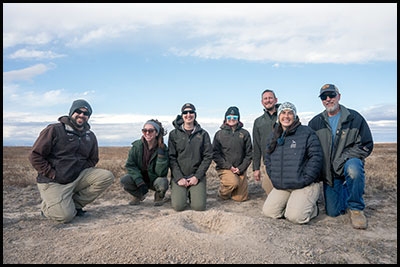
“We invite staff from all departments to participate in releases, and we especially aim to bring staff from The Loft and EdVenture department, who can share their inspiration when guests asks about Rouge – a BFF that lives in The Loft,” said Jeff Baughman, field conservation coordinator at CMZoo. Baughman manages the BFF breeding program at CMZoo and has attended annual releases for nearly 20 years. ”The experience is rewarding, and it inspires us to inspire others to care for wildlife and wild places, and continue our work contributing to conservation efforts.”
Native to prairies stretching from Mexico to Canada, BFFs were thought to be extinct in the 1980s. During Western frontier explorations in the early 1900s, cargo ships from Europe and Asia inadvertently brought sylvatic plague to North America. The spread of the plague bacteria by fleas among prairie dogs (and other animals), combined with poisoning and eradication programs led by newly settled farmers and ranchers who saw prairie dogs as pests, drastically reduced the prairie dog population. Because prairie dogs are their main food source, BFF populations declined dramatically along with them.
On Sept. 26, 1981, a ranch dog named Shep caught a BFF. Shep’s catch led to the discovery of a small population of the elusive animals in Meeteetse, Wyoming. Since then, zoos, U.S. Fish and Wildlife, National Black-footed Ferret Conservation Center and other organizations have banded together to breed, prepare, release and monitor BFFs to increase the population.
Because they or their offspring could be released to the wild, every effort is made to keep the BFFs born and raised at CMZoo as wild as possible. So, they are not visible to CMZoo guests. Guests can visit Rouge, a former breeding male that now lives in The Loft.
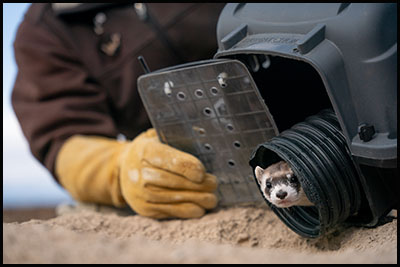
Prior to the CMZoo releases last month in Pueblo, the sites were managed for sylvatic plague through oral bait vaccines for prairie dogs living on these sites and dusting to eliminate plague-carrying fleas. Sylvatic plague transferred by fleas is now prairie dogs’ primary threat – and BFFs need prairie dogs as their primary food and shelter source. BFFs and other prairie species live in abandoned prairie dog tunnels.
“Being in the field with people who advocate for BFFs but haven’t released them before takes me back to my most inspiring black-footed ferret release at a ranch in New Mexico in 2008,” said Baughman. “On our way to the ferret release area we drove through a huge herd of powerful bison. It helped me imagine a time when bison, swift foxes, burrowing owls, prairie dogs and black-footed ferrets were abundant together in the prairie.”
“We released them before dusk and after sunset we went back to spotlight and monitor the first ferret we had released,” said Baughman. “To our surprise, it was above ground with two swift foxes. They looked almost the same size from a distance and their interaction seemed more curious and playful than threatening. It was as if they were old friends reunited after a long time apart. It looked like they were dancing on the prairie, under the moonlight, as they have done for thousands of years. The bison, the swift foxes and the prairie were truly magical. That was a day that I will remember forever.”
Bison have a similar story to the black-footed ferret. They were nearly eradicated to extinction and are now recovering with the help of people dedicated to them. Baughman sees them as proof that animals can possibly recover, and if people work together, they could potentially bring back some of the prairie ecosystem to its original splendor.
“Zoos have been so instrumental in those recoveries,” said Baughman. “The work we’ve been doing at CMZoo for 42 years, helping black-footed ferrets recover, helps the entire ecosystem because prairie species need each other.”
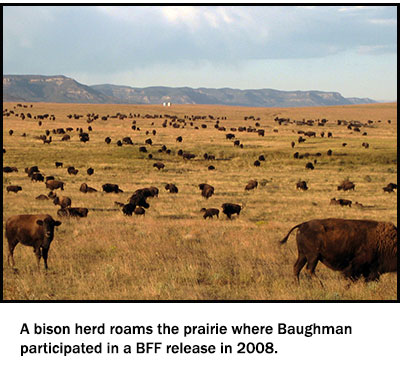
At the core of the prairie’s survival is the prairie dog. Prairie experts estimate that 170 prairie species depend on the prairie dog – and bison make life richer for the prairie dogs, which in turn support the BFFs. Bison graze differently than livestock. They cut the grass instead of uprooting it, which benefits natural vegetation, healthy drainage and nutrient-rich soil for the mostly herbivorous prairie dogs. The bison’s literal heavy presence also loosens soil, which prairie dogs dig to create tunnels that house their colonies and later become homes for BFFs and other species, like box turtles and burrowing owls.
“It is a complicated balance that we want to support without getting too involved in,” said Baughman. “Ultimately, we want a future that doesn’t need our breed-and-release program because it’s sustaining itself in the wild.”
Until then, Baughman and his inspired team will continue the work with the support of CMZoo guests and members. Back at the conservation center up above CMZoo, the meticulous yearly cycle of preparing for another breeding year has already begun. They recently welcomed new breeding females and males and are moving them through the simulated light cycle that triggers their natural instinct to breed in the spring. After such a successful breeding year, program partners are optimistic about 2024.
Every CMZoo guest helps support this important program because 75 cents from every admission goes to Quarters for Conservation, which helps fund BFF conservation and other important efforts around the world. Since 2008, Q4C has raised nearly $5 million for these programs. To learn more about the black-footed ferret breeding program and CMZoo’s Quarters for Conservation program, visit cmzoo.org/conservation.
